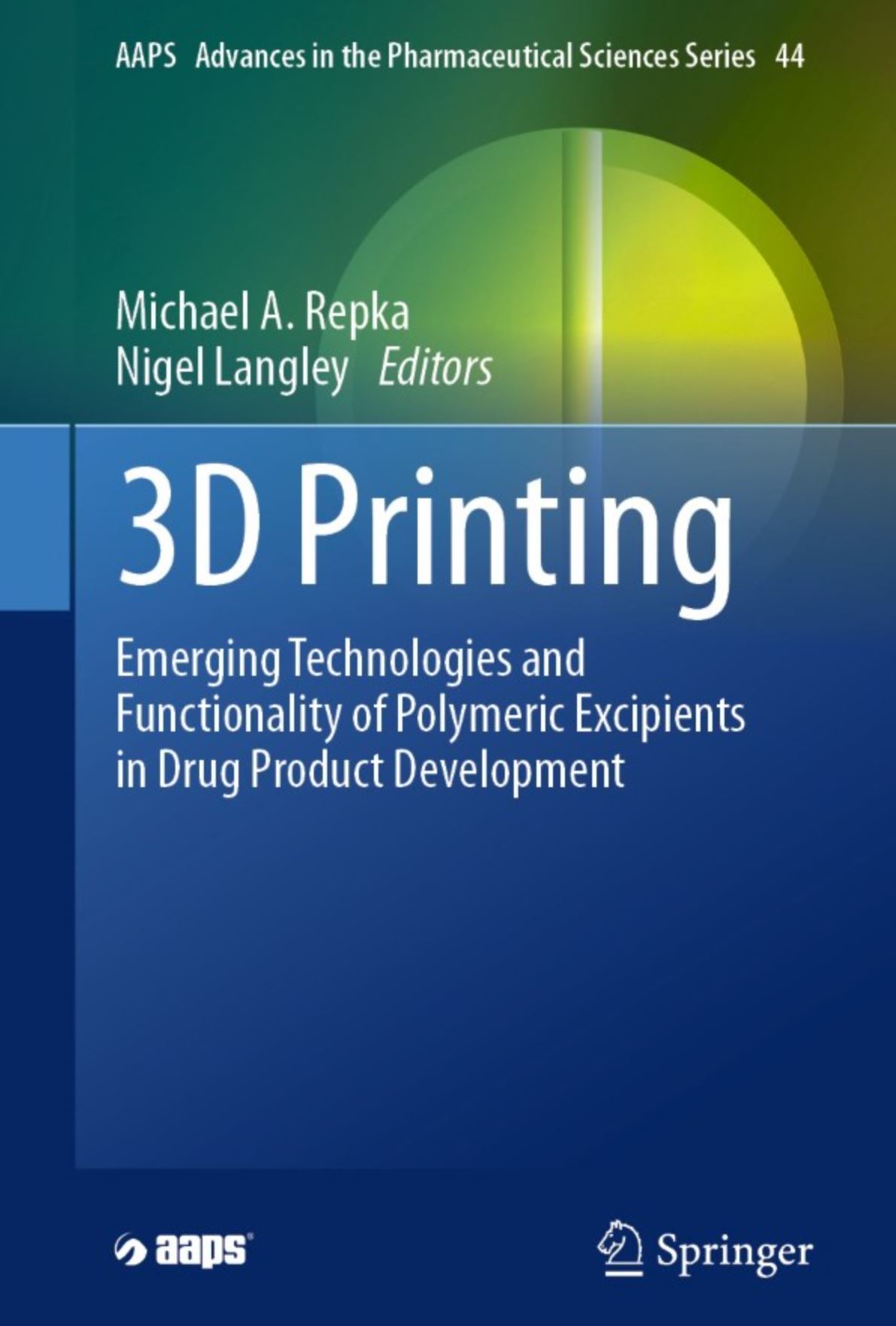3D Printing Emerging Technologies and Functionality of Polymeric Excipients in Drug Product Development – Part 1

See the new book, edited by Michael A. Repka, Nigel Langley
- Covers regulatory and manufacturing aspects of 3D printing in drug development
- Particular focus on hot melt extrusion and extruded filaments suitable for optimizing 3D printing
- Thorough short text and guide for use on the production line of 3D printing of pharmaceuticals
Description:
This inclusive text describes 3D Printing for pharmaceutical applications, including emerging 3D technologies. The book focuses on the functionality of the materials/biomaterials used for the preparation of dosage forms and devices, fundamentals for preparing these systems and novel applications using these additive manufacturing techniques. Also, the text includes clinical relevance and regulatory considerations for the future of personalized medicine.
Authored by experts with a broad range of experience, extensive insight into the science of 3D printing technology used to produce these systems is provided. Highlighting viewpoints from the academic, polymer excipient, equipment, product development and regulatory communities, this comprehensive text compiles input from industry thought leaders to illustrate strategies and technologies for applying techniques of additive manufacturing for drug product and device development while also providing insight into the path forward for the technology in years to come.
Chapter 1
Overview of Pharmaceutical 3D Printing Technologies
This chapter provides a comprehensive overview of the diverse landscape of pharmaceutical 3D printing technologies. Covering a range of approaches including powder-based, extrusion-based and photopolymerisation methods, this review highlights the distinctive attributes, advantages and challenges associated with each technique. It delves into their applications in drug formulation, personalised medicine and dosage form customisation. As can be seen in this chapter, every 3DP technique has its own advantages and disadvantages. The properties of the drug can influence the choice of the technique. However, the technique chosen influences the properties of the formulation needed to be printable and additionally determines the dosage forms that are possible. By synthesising these insights, Chap. 1 offers a holistic perspective on the evolving field of pharmaceutical 3D printing technologies, showcasing their potential to reshape drug manufacturing and patient-centric healthcare approaches.
Jacobi, D., Pyo, S.M. (2024). Overview of Pharmaceutical 3D Printing Technologies. In: Repka, M.A., Langley, N. (eds) 3D Printing . AAPS Advances in the Pharmaceutical Sciences Series, vol 44. Springer, Cham. https://doi.org/10.1007/978-3-031-46015-9_1
Chapter 2
Clinical Applications of 3D Printed Drug Products
Common challenges in pharmaceutical formulation development and clinical manufacturing include manual labor and a lack of flexibility to formulate a wide range of release characteristics that can be provided in an adaptive fashion. For instance, in Phase I clinical trials for oral delivery, thousands of capsules are manufactured with a single release profile. While the release rate in these dosage forms can be reproducible, they cannot be flexibly manipulated in a controlled manner without a significant change to the formulation or manufacturing process. In this chapter, 3D printing as an automated and versatile manufacturing technique will be explored for the purposes of small- to mid-scale pharmaceutical manufacturing, specifically focusing on oral delivery and microneedles. Unique benefits facilitated by 3D printing will be highlighted, the current technology gaps will be discussed, and future benefits will be explored.
Smith, D.M., Della Rocca, J. (2024). Clinical Applications of 3D Printed Drug Products. In: Repka, M.A., Langley, N. (eds) 3D Printing . AAPS Advances in the Pharmaceutical Sciences Series, vol 44. Springer, Cham. https://doi.org/10.1007/978-3-031-46015-9_2
Chapter 3
Quality Control and Regulatory Landscape of 3D-Printed Drug Products
This chapter provides an overview of the evolving landscape concerning the quality control (QC) and regulatory considerations surrounding 3D-printed drug products. With the advent of 3D printing in pharmaceutical manufacturing, the ability to create intricate dosage forms and personalized medications has introduced new opportunities and challenges. Effective QC strategies encompass material selection, process validation, and post-processing steps to ensure both product integrity and patient safety. The regulatory framework for 3D-printed drug products is rapidly developing, necessitating a cohesive approach to address technological complexities and ensure compliance. This chapter highlights the need for standardized methodologies, collaboration between stakeholders, and proactive regulatory engagement to fully exploit 3D printing’s potential in drug product innovation while upholding quality and regulatory standards.
Kayalar, C., Charoo, N.A., Nutan, M.T.H., Kuttolamadom, M., Khan, M.A., Rahman, Z. (2024). Quality Control and Regulatory Landscape of 3D-Printed Drug Products. In: Repka, M.A., Langley, N. (eds) 3D Printing . AAPS Advances in the Pharmaceutical Sciences Series, vol 44. Springer, Cham. https://doi.org/10.1007/978-3-031-46015-9_3
See the full book here:
Michael A. Repka, Nigel Langley, 3D Printing Emerging Technologies and Functionality of Polymeric Excipients in Drug Product Development, https://doi.org/10.1007/978-3-031-46015-9, ISBN 978-3-031-46017-3Due: 16 December 2024

